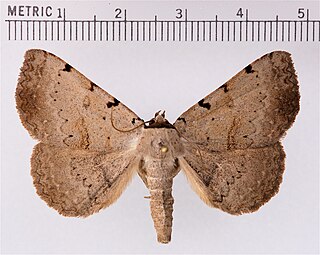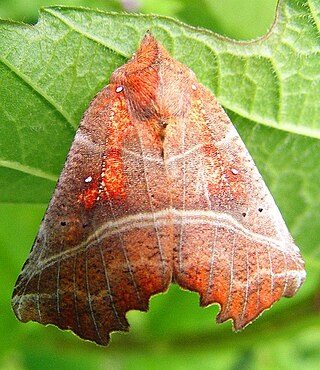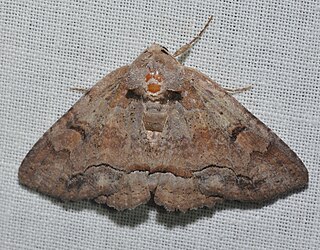
The Catocalini are a tribe of moths in the family Erebidae. Adults of many species in the tribe are called underwing moths due to their vividly colored hindwings that are often covered by contrastingly dark, drab forewings.

The Ophiusini are a tribe of moths in the family Erebidae.

The Phaegopterina are a subtribe of tiger moths in the tribe Arctiini, which is part of the family Erebidae. The subtribe was described by William Forsell Kirby in 1892. 469 species of Phaegopterina are present and 52 that are recently discovered in Brazil.

The Ctenuchina are a subtribe of moths in the family Erebidae.
Bandelia is a genus of moths of the family Erebidae.
Phlyctaina is a monotypic litter moth genus of the family Erebidae. Its only species, Phlyctaina irrigualis, is found in North America. Both the genus and species were first described by Heinrich Benno Möschler in 1890.

The Erebinae are a subfamily of moths in the family Erebidae erected by William Elford Leach in 1815. Erebine moths are found on all continents except Antarctica, but reach their greatest diversity in the tropics. While the exact number of species belonging to the Erebinae is not known, the subfamily is estimated to include around 10,000 species. Some well-known Erebinae include underwing moths (Catocala) and witch moths (Thermesiini). Many of the species in the subfamily have medium to large wingspans, up to nearly 30 cm in the white witch moth, which has the widest wingspan of all Lepidoptera. Erebine caterpillars feed on a broad range of plants; many species feed on grasses and legumes, and a few are pests of castor bean, sugarcane, rice, as well as pistachios and blackberries.

The Anobinae are a subfamily of moths in the family Erebidae described by Jeremy Daniel Holloway in 2005. Common morphological characteristics of Anobine moths include a dark head and prothoracic collar, lighter color on the thorax, and either bipectinate antennae or antennae with flagellomeral setae in males.

The Boletobiinae are a subfamily of moths in the family Erebidae, containing about 956 species. The taxon was described by Achille Guenée in 1858.

The Hypenodinae are a subfamily of moths in the family Erebidae. Adult moths of most species of this subfamily lack small, simple eyes near the large, compound eyes and have quadrifine (four-veined) hindwing cells. The micronoctuid moths are an exception because they possess simple eyes and bifine (two-veined) hindwing cells.

Eulepidotinae is a subfamily of moths in the family Erebidae. Adult males in the subfamily have midtibial tufts of hairs. Adult females have the ostial opening located between the seventh and eighth abdominal sternites instead of located anteriorly on the seventh sternite.

The Scoliopteryginae are a subfamily of moths in the family Erebidae. Larvae have distinctive, extra setae on the first through seventh abdominal segments. Many adult moths in the subfamily have a proboscis adapted to pierce fruit skin, allowing consumption of the juice in the fruit.
The Toxocampinae are a subfamily of moths in the family Erebidae. Moths in the subfamily typically have a primitive form of genital claspers similar to those of some subfamilies of the Noctuidae.

The Melipotini are a tribe of moths in the family Erebidae.

The Poaphilini are a tribe of moths in the family Erebidae.

The Thermesiini are a tribe of moths in the family Erebidae.

Zale confusa, the confused zale moth, is an owlet moth in the family Erebidae. The species was first described by James Halliday McDunnough in 1940. It is found in North America.
Matigramma inopinata is a species of moth in the family Erebidae. It is found in North America.
Matigramma obscurior is a species of moth in the family Erebidae. It is found in North America.
Hypena degesalis is a species of moth in the family Erebidae. It is found in North America.














